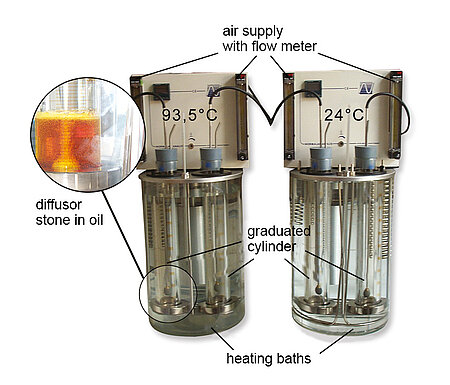
| OELCHECK test instrument: | Normalab Analis P 643 |
| Sample quantity: | 410 ml |
| Unit: | ml/ml |
| Test result: | foaming tendency seq. I (24 °C) at routine check foaming tendency seq. II (93.5 °C) option foaming tendency seq. III (24 °C after 93.5 °C) option |
| Result range: | 0 - 1,000 ml/ml |
| Analysis for: | circulating, turbine and hydraulic oils |
| Brief description: | Air in the form of tiny bubbles is introduced into the oil being tested using a spherical, porous stone. These form an air in oil dispersion and rise to the surface, where a layer of foam is formed as air bubbles constantly appear and burst. After five minutes, the air supply is disconnected. The foam volume on switch-off and the remaining foam volume after 10 minutes are measured. The same procedure is carried out with a second oil sample, first at 93.5 °C, then at 24 °C. The foam volumes at 24 °C, at 93.5 °C and then at 24 °C respectively on switch-off of the air supply and 10 minutes later are given. |
| Statement: | The foaming tendency of lubricants can deteriorate as a result of impurities and oxidation. Excess foam can reach areas under high strain and impede the development of a hydrodynamic lubricating film. Surface foam can cause leaking, if foam swells through seals and ventilation spouts. Foam occurs when gas bubbles from the oil rise to the surface and do not burst. It consists of gas-filled cells whose walls are formed by thin lamellae of liquid. In the testing instrument, the time taken until the foam disintegrates is observed. This allows its behaviour during use to be assessed. Anti-foaming additives containing silicon can be used to reduce foam. However, silicone oil may markedly deteriorate the air separation characteristic of oils. |
| Underlying test standard: | ASTM D892 |